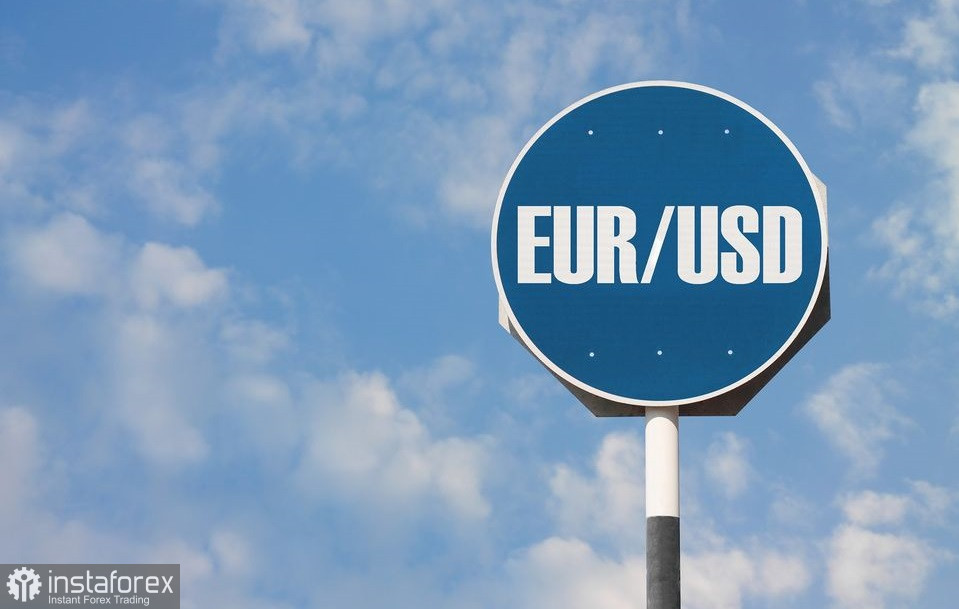For instance, on Wednesday, EUR/USD bears tried to pull the price down to the middle of the 1.06 level, marking a nearly two-month price low at 1.0667. However, by the end of the US session, the bulls seized the initiative. On Thursday, they were already looking to play their hand – trying to approach the resistance level of 1.0750 (the upper line of the Bollinger Bands on the 4-hour chart).
In general, the pair is stuck within a 100-pip price range. The bears failed, but we have not yet seen a counter-attack from the bulls. Traders can't decide on the direction.

The final figures for the first quarter's GDP growth were published in the US. The initial estimate was at 1.6%. According to the second estimate, the figure was revised downward to 1.3%. The final estimate showed that the US economy expanded 1.4% in the first quarter of 2024. GDP price inflation was revised to 3.1% from 3.0% in the second estimate.
At the same time, consumer spending increased by 1.5%. The initial estimate was 2.0%. Spending on appliances, furniture and other goods fell by a 2.3% annual rate, while spending on travel, restaurant meals and other services rose by 3.3%. The PCE consumer price index in the first quarter rose by 3.4% (the highest growth rate over the past year), after increasing by 1.8% in the fourth quarter of 2023. The core PCE inflation index, excluding food and energy prices, rose by 3.7% (initial estimate was 3.6%), after increasing by 2% in the previous quarter.
The latest figures were interpreted against the US dollar, to be more specific, "not in favor of the dollar." Although overall, the final assessment of the indicator almost entirely matched the second assessment, and the components were revised upwards.
In addition, some of the US economic reports were also in the "green." For instance, new orders for manufactured durable goods increased 0.1% in May, while most experts had forecasted a 0.5% decline. US unemployment claims dropped to 233,000 last week, against a forecast of an increase of 236,000. As a reminder, this indicator has shown a downward trend for the second consecutive week.
The only indicator that was in the "red" was the US real estate market. Pending home sales declined 2.1% in May from the prior month (against a forecast of a 0.6% increase), and by 6.6% on a year-on-year basis (against a forecast of -4.0%). This indicator is an early gauge of US housing market activity (as processing typically takes several weeks), therefore the dollar remained under pressure.
Overall, the EUR/USD pair continues to drift within the aforementioned price range. Despite their "fierce attack", buyers couldn't even consolidate above the intermediate resistance level of 1.0720 (Tenkan-sen line on the daily chart). For a pivot, EUR/USD bulls need to rise at least above the 1.0780 mark (the middle line of the Bollinger Bands indicator on the D1 timeframe).
The bears also face a challenging task: they need to consolidate below the support level of 1.0670 (the lower line of the Bollinger Bands on the 4-hour chart). On Wednesday, traders tried to push through this price barrier, but in vain.
In my opinion, the pair will continue to trade in the price range of 1.0650-1.0750: buyers will try to approach the upper boundary of the range, while sellers will aim for the lower one. The scales may tip to one side or the other on Friday, when the most important inflation indicator for the Federal Reserve - the core Personal Consumption Expenditures index - will be published.
Just a quick heads up, the core PCE index remained unchanged at 2.8% in April, although some experts predicted it to accelerate. According to forecasts, it will shift in May, but towards a decrease, reaching the mark of 2.6%. However, if contrary to forecasts the index picks up pace, the dollar will strengthen across the market, as in such a case, the prospects for a rate cut in September will be in question. An increase would strengthen the Fed's hawkish stance.
Thus, at the moment, there are no grounds for a sustained increase/decrease in price. If the core PCE index does not present any surprises, the pair will likely finish the week close to the target of 1.0700, i.e., within the range of 1.0650-1.0750. A sharp rise in the core PCE index will pull the price to the bottom of the 1.06 level. But if the indicator comes out below the 2.6% mark, the bulls will try to break through to the boundaries of the 8th price level.
 English
English 
 Русский
Русский Bahasa Indonesia
Bahasa Indonesia Bahasa Malay
Bahasa Malay ไทย
ไทย Español
Español Deutsch
Deutsch Български
Български Français
Français Tiếng Việt
Tiếng Việt 中文
中文 বাংলা
বাংলা हिन्दी
हिन्दी Čeština
Čeština Українська
Українська Română
Română

